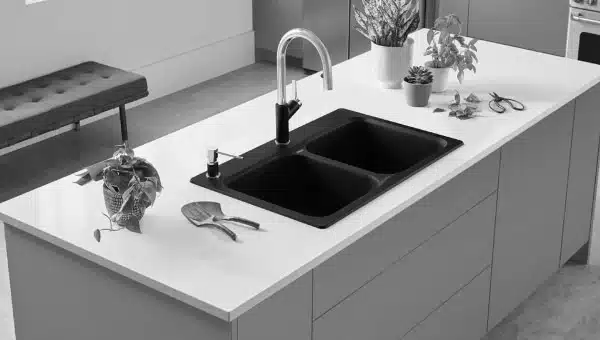When I first embarked on the journey of renovating my kitchen and bathroom, the thought of sink installation seemed daunting. I had images of plumbing nightmares and water flooding my newly laid floors. However, I quickly learned that with the right information and approach, installing a sink can be more straightforward than it appears. In this blog post, I aim to share my experience and insights to help demystify the process of sink installation for fellow home renovators.
Table of Contents
The Art of Choosing the Right Sink
Navigating through the vast sea of sink options was an adventure in itself. At first, I was genuinely overwhelmed by the sheer variety available in the market. There were stainless steel sinks that boasted durability, ceramic ones that exuded elegance, and composite sinks that promised the best of both worlds. The shapes and sizes varied just as widely, from deep, functional basins for the kitchen to delicate vessel sinks for the bathroom. My quest to find the ideal sink felt like searching for a needle in a haystack.
The breakthrough came when I started to think critically about my daily routines and the specific demands I placed on each sink. In my kitchen, where meal prep and cleanup take center stage, the need for a robust, easy-to-clean sink was apparent. I chose a deep, single basin sink made of stainless steel, not just for its resilience but also for its ability to handle the chaos of cooking and cleaning. Its simplicity and functionality spoke to my practical needs, while its sleek design aligned with my aesthetic preferences.
For the bathroom, my priorities shifted towards creating a space that felt serene and uncluttered. I opted for an undermount sink that blended seamlessly with the marble countertop, enhancing the room’s elegance. This choice was driven by my desire for a clean, streamlined look that would make my bathroom feel like a retreat from the world.
Throughout this selection process, I learned the importance of marrying form and function. It wasn’t just about picking the most attractive sink or the one with the best reviews. It was about understanding how a sink could fit into and enhance my daily life. By considering my practical needs and aesthetic desires, I was able to choose sinks that not only looked beautiful but also served their purpose remarkably well, making my home more functional and inviting.
Comparing Wall Mount, Pedestal & Drop In Sinks
Mastering sink installation is crucial for homeowners looking to upgrade their bathrooms or kitchens with style and functionality. The type of sink you choose not only impacts the overall aesthetics of your space but also affects the installation process and long-term maintenance. In this post, we’ll dive deep into the world of wall mount sinks, pedestal sinks, and drop-in sinks, comparing their features, installation processes, and how to determine which type is the best fit for your home.
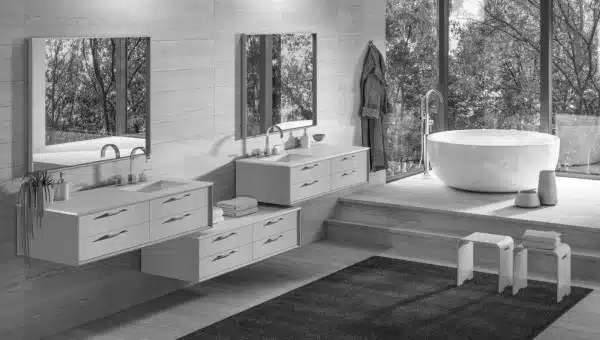
Wall Mount Sinks: Space-Savers with a Modern Flair
Wall-mounted sinks serve as an innovative solution for optimizing bathroom space, particularly in compact areas. Their design allows them to be mounted directly onto the wall, eliminating the need for bulky cabinets or vanities. This not only frees up valuable floor space but also contributes to a cleaner, more streamlined look in your bathroom. The aesthetic appeal of wall mount sinks is undeniable; they can effortlessly imbue any space with a contemporary vibe, making them a favorite among homeowners who favor modern interior designs.
Installing a wall mount sink involves a few critical considerations to ensure stability and functionality. The wall to which the sink will be attached must have the structural integrity to support the weight of the sink when it is in use. This might mean reinforcing the wall in certain installations or ensuring that the mounting hardware is securely anchored into wall studs. Additionally, the plumbing setup for wall mount sinks is unique. The water supply and drain pipes need to be routed through the wall directly where the sink will hang, a factor that might require the expertise of a professional plumber to ensure everything aligns perfectly.
The allure of a wall mount sink extends beyond its space-saving capabilities and modern design. Its installation allows for a customizable height, making it accessible for users of all ages and abilities, an often overlooked advantage in bathroom design. However, prospective installers should be mindful of the necessary prep work and potential adjustments to existing plumbing that may be required. Despite these preliminary steps, the outcome is a sleek, floating sink that enhances the functionality and style of the bathroom, making wall mount sinks a compelling option for those looking to maximize their space with a modern touch.
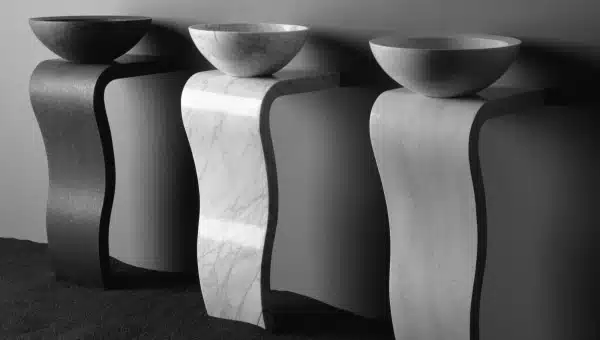
Pedestal Sinks: Classic Elegance Meets Simplicity
Pedestal sinks, embodying a blend of sophistication and straightforward design, remain a favored choice for those aiming to inject their bathroom spaces with a hint of traditional charm. Characterized by their two-part composition, these fixtures feature a basin atop a slender pedestal that gracefully conceals the plumbing. Their installation, often perceived as more manageable than other types, chiefly hinges on proper alignment with existing plumbing connections, streamlining the process for both professionals and adept DIYers alike.
Beyond their ease of installation, the architectural structure of pedestal sinks plays a pivotal role in their appeal. The visible pedestal not only supports the basin but also serves a dual purpose by elegantly masking pipework, thus maintaining the aesthetic integrity of the bathroom. This clever design feature permits pedestal sinks to integrate seamlessly into a variety of bathroom layouts without the necessity for extensive cabinetry or counter space, making them particularly suitable for tighter areas where space is at a premium.
Yet, it’s the unassuming elegance of pedestal sinks that truly sets them apart. With their graceful lines and uncluttered form, they can transform any bathroom into a serene retreat reminiscent of bygone eras. This timeless appeal, coupled with the ability to harmonize with both contemporary and traditional decors, positions pedestal sinks as a versatile option for homeowners seeking to blend functionality with enduring style.
The primary consideration for potential users, however, might be the trade-off between the aesthetic allure and the practical aspects of storage. Unlike vanity-mounted options, pedestal sinks offer minimal to no space for storing toiletries and bathroom essentials directly beneath the sink. This limitation encourages creative solutions for organizing and storing bathroom necessities elsewhere, thereby influencing the overall layout and functionality of the bathroom space.
In essence, the choice of a pedestal sink invites a marriage of form and function, where the simplicity and elegance of the design can inspire a bathroom ambiance that feels both refined and inviting, making it a distinguished choice for those looking to create a space of classic beauty.
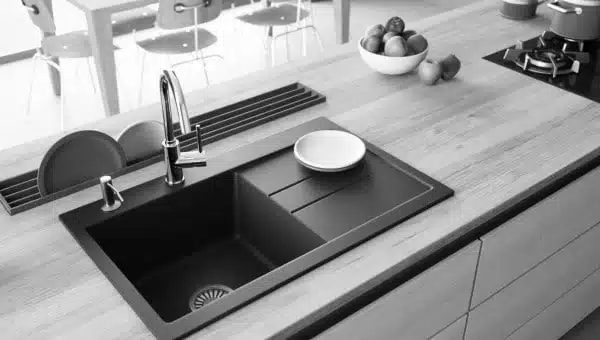
Drop In Sinks: The Classic Choice for Versatility and Ease of Installation
Drop-in sinks, celebrated for their straightforward installation, offer a blend of versatility and aesthetic appeal that seamlessly integrates into both kitchen and bathroom spaces. Known also as self-rimming sinks, their design features an edge that rests atop the countertop, ensuring a neat and tidy appearance. This distinct edge not only contributes to a clean look but also aids in the containment of water spills, making cleanup a breeze.
The allure of drop-in sinks lies in their compatibility with a wide array of countertop materials. Whether your counters are crafted from laminate, solid surface materials, or ceramic tile, these sinks can be effortlessly incorporated, thanks to their flexible installation process. The simplicity begins with preparing a pre-cut hole in the countertop, sized to the sink’s dimensions. Once cut, the sink is positioned into the opening and anchored into place using caulking and clips from beneath, creating a secure and stable fit. This process, devoid of the need for complex plumbing adjustments, is what makes drop-in sinks an attractive option for DIY enthusiasts eager to undertake a straightforward home improvement project.
Another advantage of drop-in sinks is their contribution to the design continuity within a space. Available in a plethora of materials, colors, and styles, they allow homeowners to maintain or enhance the existing decor of their bathroom or kitchen. Whether the aim is to achieve a sleek, modern look with stainless steel or a warm, traditional feel with porcelain, there’s a drop-in sink to suit every taste and design motif.
The practicality of drop-in sinks extends beyond their ease of installation. Their design facilitates easy access for cleaning the countertop surface around the sink, making them a low-maintenance option for busy households. However, it’s essential to ensure the sealing around the sink’s edge is kept in good condition to prevent water damage to the countertop below, preserving the integrity and appearance of both the sink and the surrounding area.
Comparing Installation Difficulty and Maintenance
Sink installation varies widely in terms of complexity and maintenance requirements, directly influencing a homeowner’s choice based on their comfort with DIY projects and long-term upkeep considerations. When comparing wall mount, pedestal, and drop-in sinks, each presents unique challenges and benefits from an installation and maintenance perspective.
Wall mount sinks demand a higher level of installation expertise due to the need for solid wall support and precision in plumbing alignment. This type of sink necessitates ensuring the wall can bear the sink’s weight, a task that may involve reinforcing the wall structure or securing the sink to studs. The plumbing must be discreetly routed within the wall, often requiring the skills of a professional plumber to achieve the correct setup. Maintenance for wall mount sinks generally revolves around checking the stability of the mount over time to prevent any loosening.
Pedestal sinks, on the other hand, offer a somewhat simpler installation process. The key lies in aligning the sink with existing plumbing and ensuring the pedestal is properly supporting the basin. While the plumbing is neatly concealed, it’s important to ensure that both the sink and pedestal are level and securely connected. Maintenance involves occasional inspections to confirm the pedestal and sink remain in firm alignment and the concealed plumbing does not leak.
Drop-in sinks are widely regarded as the easiest to install, suitable for a broad range of DIY abilities. The process involves fitting the sink into a pre-cut countertop opening and securing it from below, a task that can typically be accomplished with minimal tools. The primary maintenance consideration for drop-in sinks is the sealant around the sink’s edge, which must be kept intact to prevent water damage to the countertop.
Each sink type’s installation and maintenance requirements reflect a balance between aesthetic preference and practicality. Homeowners must weigh these factors against their personal skills and the functionality needs of their space to choose the most suitable sink option.

Making the Right Choice for Your Home
Selecting the perfect sink for your renovation or update requires careful consideration of several key factors. It’s not just about the look; it’s about how the sink will function within your space, the ease with which you can install it, and the ongoing care it will need.
For those leaning towards a sleek, modern aesthetic and are dealing with smaller spaces, wall mount sinks can significantly enhance the area’s visual appeal while maximizing floor space. Their installation might be more involved, requiring a bit more upfront work and possibly the assistance of a professional, but the payoff in terms of style and space efficiency can be substantial.
For homeowners drawn to a more classic or traditional bathroom ambiance, pedestal sinks stand out as a charming option. They are less demanding in terms of installation compared to wall-mounted models and offer an elegant solution that cleverly hides plumbing fixtures. While they don’t offer storage space, their aesthetic appeal and relatively straightforward installation process make them a worthy contender for those prioritizing simplicity and style.
On the other hand, drop-in sinks appeal to those looking for versatility and straightforward DIY installation. They are compatible with a wide range of countertop materials and styles, making them a flexible choice for both kitchens and bathrooms. The main consideration post-installation is the upkeep of the seal around the sink, ensuring it remains water-tight to avoid any potential damage to the countertop.
In making your selection, reflect on the specific needs of your space, your personal style preferences, and how much time and effort you are willing to invest in the installation process. By considering these aspects, you’ll be better equipped to choose a sink that not only looks great but also meets your functional requirements and maintenance capabilities, ensuring a successful home improvement project.
Exploring the Aesthetics of Vessel, Farmhouse, and Island Sinks
In recent years, the choice of sinks has become a pivotal decision in home renovation projects, with the aesthetics of the sink playing a significant role in defining the overall style of a space. Whether you’re upgrading your kitchen or bathroom, the sink installation process is an opportunity to infuse elegance, functionality, and a bit of your personality into the room. Among the various types of sinks, vessel, farmhouse, and island sinks stand out for their unique attributes and ability to transform a space. Let’s dive into the details of each to understand why they’ve become favorites among homeowners and interior designers alike.
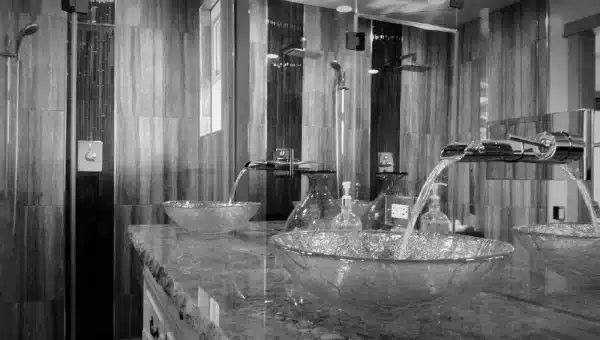
The Rising Popularity of Vessel Sinks in Modern Bathrooms
Vessel sinks have become a hallmark of sophistication and design flexibility in contemporary bathrooms. These above-counter basins have a rich history, drawing inspiration from the traditional washbasin and pitcher setup, yet have been reimagined to suit the modern homeowner’s tastes and needs. Their distinct presence in a bathroom is not just a nod to aesthetic preferences but a bold statement of individual style. Available in an array of materials such as elegant glass, rugged stone, sleek ceramic, and polished metal, vessel sinks cater to a broad spectrum of design sensibilities.
One of the notable advantages of opting for a vessel sink is the illusion of more space it creates. By being mounted atop the counter, it allows for the maximization of vanity space underneath, making it a practical choice for bathrooms of all sizes. The installation process of vessel sinks is another aspect that adds to their growing popularity. Unlike traditional sinks that require extensive modifications to countertops, vessel sinks can often be mounted with minimal adjustments, offering a straightforward update that can significantly impact a bathroom’s look and feel.
However, it’s essential to give thought to the ergonomics of using a vessel sink. The height of the vanity and the choice of faucet are critical considerations to ensure that the setup is not only visually pleasing but also functional and comfortable for daily use. The integration of a vessel sink into a bathroom design demands a balance between aesthetic appeal and practicality, emphasizing the importance of selecting the right combination of sink, vanity, and faucet to achieve a cohesive and inviting space.
The increasing preference for vessel sinks in bathroom renovations speaks to a desire for pieces that combine form with function, offering a way to personalize the space while enhancing its usability. With their design versatility and ease of installation, vessel sinks are poised to remain a top choice for homeowners looking to add a touch of luxury and personality to their bathrooms.
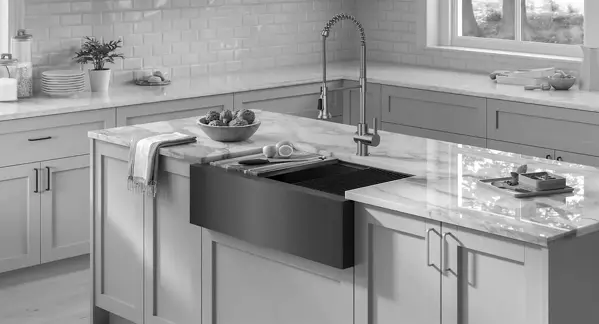
Farmhouse Sinks: Blending Functionality with Rustic Charm
Farmhouse sinks, emblematic of a time when practicality met simplicity, have evolved to become a sought-after element in both traditional and contemporary kitchens. Known for their substantial depth and distinctive exposed front, these sinks facilitate a range of kitchen tasks, from handling oversized cookware to assisting in the clean-up after a large family meal. The design, rooted in the utilitarian needs of early farmhouses, seamlessly integrates functionality with a rustic aesthetic, making it a perfect blend for today’s lifestyle where the kitchen is both a place of work and gathering.
The appeal of farmhouse sinks extends beyond their practicality, tapping into a desire for a kitchen that feels both welcoming and lived-in. Available in materials like the classic fireclay, durable stainless steel, and the elegantly patina-prone copper, these sinks can anchor a kitchen’s design, bridging the gap between modernity and tradition. Their versatility in style enables them to be the centerpiece in a variety of kitchen themes, from the cozily traditional to the sleekly modern.
The installation of a farmhouse sink is an endeavor that requires foresight and planning. Unlike standard sink types that fit into pre-existing cabinetry and countertop layouts, farmhouse sinks often necessitate custom modifications to the surrounding cabinetry to accommodate their unique apron-front design. This customization, while demanding, offers a tailor-made aspect to kitchen design, allowing for a level of personalization that is both rare and desirable.
Adopting a farmhouse sink into your kitchen is more than a nod to the nostalgic; it’s a commitment to a lifestyle that values the beauty in functionality and the charm in durability. Its presence in a kitchen speaks to a preference for timeless design elements that are as practical as they are aesthetically pleasing, ensuring that the heart of the home is not just equipped for culinary tasks but is also a testament to a bygone era’s enduring appeal.
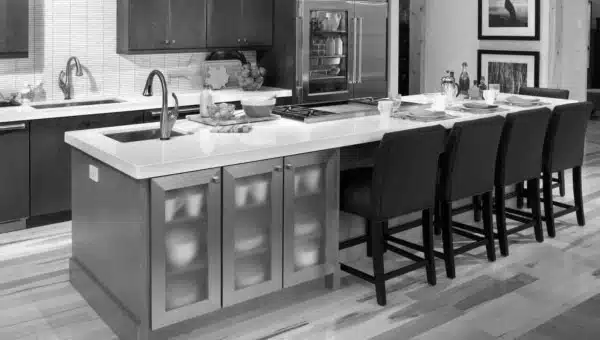
Island Sinks: Enhancing Kitchen Workflow and Entertainment
Island sinks have emerged as a strategic addition to modern kitchen designs, aimed at optimizing both the culinary workflow and the overall entertainment experience within the space. Positioned within the kitchen island, these sinks serve as an auxiliary workstation, freeing up the primary sink for more demanding tasks. This spatial configuration not only streamlines the cooking process but also fosters a more interactive environment, enabling hosts to engage with their guests while attending to meal preparation.
The utility of an island sink extends to various kitchen activities, from simplifying the washing of fruits and vegetables to providing a convenient spot for mixing drinks, all without disrupting the main cooking area. This dual-sink approach effectively divides kitchen tasks, promoting a more organized and efficient culinary workspace.
When considering the integration of an island sink, a range of design options is available to complement the existing kitchen décor. Whether the preference is for an undermount sink that offers a sleek, continuous countertop line or a top-mount version that makes a statement, the materials and styles available can accommodate any aesthetic preference. This versatility ensures that the island sink not only enhances functionality but also contributes to the overall design cohesion of the kitchen.
The planning and execution of an island sink installation demand attention to detail, particularly in regards to plumbing requirements and the allocation of sufficient countertop space. The logistical considerations, while significant, are a worthwhile investment for the added value and convenience an island sink brings to the kitchen environment. By facilitating a more efficient use of space and encouraging social interactions during meal preparation, an island sink becomes an indispensable feature for any kitchen aimed at blending culinary functionality with a welcoming atmosphere for entertainment.
Considerations for Seamless Sink Installation
Achieving a flawless sink installation necessitates a thoughtful approach to several key factors beyond just the aesthetic appeal of the sink. Firstly, ensuring that the chosen sink is compatible with your home’s existing plumbing infrastructure is paramount. This may involve adjustments or upgrades to accommodate the specific requirements of vessel, farmhouse, or island sinks, which could have unique drainage and faucet configurations.
Accurate measurements are critical to the successful installation of any sink type. A misjudgment in size can lead to issues with sink fitment into countertops or cabinetry, especially in the cases of farmhouse and island sinks, which often require precise cuts in the surrounding materials. It’s imperative to take into account not only the dimensions of the sink itself but also any additional space needed for mounting hardware or necessary clearance.
The selection of materials plays a significant role in the longevity and maintenance of your sink. Each material, from the sleek elegance of glass in vessel sinks to the rugged durability of stainless steel in farmhouse models, carries its own set of maintenance needs and durability considerations. Your lifestyle and the intended use of the sink should guide your material choice, ensuring that it stands up to the demands of your daily routines.
Professional consultation is highly recommended, particularly for installations that involve complex configurations or custom modifications. A skilled plumber or contractor can provide valuable insights into the unique challenges posed by your chosen sink type, helping to navigate issues related to plumbing modifications, cabinet alterations, or the integration of the sink into existing or new countertops.
Taking these factors into account from the outset of your sink installation project can pave the way for a smooth process, from the selection of the perfect sink to its final integration into your home. By focusing on compatibility, accurate measurements, material selection, and professional guidance, you can achieve an installation that not only meets but exceeds your expectations.
Wrapping It Up: Transform Your Home with the Right Sink
In concluding, selecting the ideal sink is more than an upgrade—it’s a strategic choice that enhances both the visual appeal and the practicality of your living spaces. The distinct qualities of vessel, farmhouse, and island sinks offer unique opportunities to personalize and improve your kitchen or bathroom.
Vessel sinks elevate the elegance and modernity of bathrooms, providing a versatile centerpiece that reflects your taste. Farmhouse sinks, with their deep basins and rustic allure, infuse kitchens with a blend of tradition and functionality, making every culinary task a pleasure. Meanwhile, island sinks introduce a layer of efficiency and sociability to the kitchen layout, transforming meal preparation into an engaging experience for everyone involved.
The journey to selecting and installing the perfect sink involves careful consideration of several factors. Beyond the immediate visual appeal, it’s crucial to assess the compatibility with your existing plumbing, the practicality of daily use, and the long-term durability of the materials. The decision-making process should be thorough, with an eye toward how each type of sink aligns with your home’s style and your personal lifestyle needs.
Engaging with a professional for the installation can ensure that your chosen sink not only fits seamlessly into your space but also functions flawlessly. Their expertise can help circumvent potential challenges, making the transition smooth and stress-free.
Ultimately, the choice of sink has the power to redefine a room, marrying aesthetics with utility in a way that resonates with your vision for your home. By giving due diligence to the selection and installation process, you can transform a simple functional fixture into a statement piece that elevates the everyday into something truly special.
DIY vs. Professional Installation: Navigating the Waters
Embarking on the adventure of sink installation presented me with a pivotal decision point: to dive into the project with a DIY spirit or to seek the expertise of a professional. My natural inclination leans toward tackling home improvement projects on my own, relishing the satisfaction of personal achievement and the opportunity to learn something new. However, I quickly recognized that sink installation, with its intricate plumbing demands, stood on a different playing field.
The allure of saving money and the thrill of hands-on problem-solving initially tempted me to approach the kitchen sink installation as a DIY project. Yet, after delving into the specifics, I realized the complexity of the task at hand. The kitchen, being the heart of my home, required a level of precision and expertise I wasn’t confident I possessed. The fear of improper installation leading to leaks, water damage, or worse, made me pause and reassess.
In contrast, the bathroom sink installation seemed less daunting. The project appeared more straightforward, with fewer variables and risks involved. This realization nudged me towards splitting my approach: hiring a professional for the kitchen, where the stakes and complexity were higher, and taking on the bathroom as a DIY venture. This dual approach allowed me to balance my desire for personal involvement with the practical need for technical proficiency.
This decision-making process underscored a valuable lesson: understanding and respecting the limits of my own skills and knowledge. It illuminated the importance of evaluating each project’s unique challenges and recognizing when to call in professionals to ensure a job well done. By carefully navigating these waters, I was able to ensure the success of both installations, merging the satisfaction of DIY achievement with the peace of mind that comes from professional expertise.
The Hidden Benefits of a Proper Sink Installation
As I journeyed deeper into my home renovation project, I discovered that the benefits of a proper sink installation extended far beyond mere aesthetics and functionality. Initially, I was solely focused on how the sink would look and serve in my day-to-day life. However, as I delved into the installation process—first with hesitation and then with growing confidence—I began to uncover the hidden perks that a correctly installed sink could offer.
First off, I didn’t fully appreciate how vital a well-installed sink is for preventing water damage and the dreaded mold growth. Ensuring that all the connections were watertight and secure gave me peace of mind, knowing that I wouldn’t unexpectedly encounter water leaking into the cabinetry or flooring. This was particularly enlightening, as I hadn’t considered the catastrophic effects a small leak could have over time, from rotting wood to promoting mold that could potentially affect my family’s health.
Another surprising benefit was the reduction in noise. I chose a kitchen sink with an undercoating and pads on the underside, not fully realizing the impact it would have. The difference was night and day. Gone were the echoing sounds of dishes being washed or water being poured, replaced with a muffled, more pleasant sound. This small detail significantly enhanced the tranquility of my kitchen space, making it a more enjoyable place for culinary experiments and gatherings.
Lastly, I realized that a properly installed sink did indeed become a focal point in my home, much more than I had anticipated. It wasn’t just a fixture but a statement piece that drew eyes and compliments, enhancing the room’s overall appeal. This discovery was unexpected but deeply satisfying, as it reinforced the value of my renovation efforts in both the kitchen and bathroom.
Through this process, I learned that the hidden benefits of a proper sink installation are manifold, touching on aspects of home maintenance, comfort, and beauty that I hadn’t fully considered before. These insights have enriched my renovation experience, adding layers of value to what initially seemed like a simple project.
Enhancing Your Home’s Value and Aesthetics
As my renovation journey unfolded, the transformative power of a new sink installation in enhancing my home’s value and aesthetics became undeniably clear. Moving beyond the initial choice of sink material and design, the true potential of this upgrade started to shine through, particularly in the kitchen and bathroom, the cornerstones of my project.
In the kitchen, selecting a sleek, stainless steel sink didn’t just meet my practical needs; it also became a striking centerpiece. This sink, with its clean lines and gleaming surface, elegantly tied together the countertops and cabinetry, breathing new life into the entire space. It was more than just a place for washing dishes; it became a focal point that made the kitchen more inviting and cohesive.
Similarly, in the bathroom, opting for an undermount sink was a game-changer. This choice complemented the marble countertop beautifully, creating a seamless and sophisticated look that significantly elevated the room’s elegance. This upgrade wasn’t merely about functionality; it was about crafting a space that felt both luxurious and tranquil—a haven within my own home.
These changes had a palpable impact, not just on the daily experience of living in my house but also on its overall market appeal. It became clear to me that these thoughtful upgrades could significantly contribute to my home’s resale value. Potential buyers would likely appreciate both the aesthetic appeal and the practical improvements, seeing the house not just as a living space but as a carefully curated environment.
This realization brought a new level of satisfaction to my renovation efforts. The decision to invest in quality sink installations was validated not only by the immediate visual and functional enhancements but also by the potential long-term benefits to my home’s value. Through this process, I learned that sometimes, the most impactful upgrades are those that blend seamlessly into the fabric of our living spaces, elevating them in ways we hadn’t imagined.
Conclusion: Embrace the Challenge
Reflecting on my adventure in sink installation, it’s clear this journey was about more than just adding a new fixture to my home. It became a deep dive into the nuances of home improvement, pushing me to explore the intersections of aesthetics, functionality, and the personal satisfaction that comes from a job well done.
At the outset, I viewed this task with a mix of excitement and apprehension, unsure of whether I was up to the challenge. Yet, as I navigated each step—from selecting the perfect sink to deciding between DIY and professional installation—I found myself growing more confident in my abilities and decisions.
This process taught me the value of thorough research and planning, the importance of balancing personal involvement with professional expertise, and the unexpected joys that come from enhancing my home’s environment. More than that, it revealed the profound impact such projects can have on our personal spaces, transforming them in ways both visible and intangible.
To my fellow home renovators contemplating their next project, I offer this insight: while the path may seem fraught with potential obstacles, the rewards of pushing through are immense. Sink installation, as I discovered, is not merely a technical task but an opportunity to imprint a piece of yourself on your home, to create something both beautiful and functional that speaks to your unique needs and preferences.
So, as you stand on the brink of your own renovation endeavors, remember that the challenges you face are simply stepping stones on the path to a more fulfilling and personalized home environment. Embrace each challenge with an open heart and a willing spirit, and you may find, as I did, that the journey enriches you in ways you never anticipated.
FAQs About Sink Installations
How much should it cost to install a sink?
The cost of sink installation or upgrade in a home falls within the range of $300 to $600, which is recommended for most homeowners by HomeAdvisor. However, the cost can vary between $250 to $650 as per the estimates provided by Angie’s List. Plumbers usually charge around $100 to $200 per hour for installing a new kitchen sink, which is the standard rate prevailing in the industry.
Can I install a sink myself?
Undertaking a do-it-yourself project to replace a kitchen sink can yield significant benefits. As a sink experiences constant use over time, it inevitably wears out and requires replacement. Not only does the installation of a new sink enhance the visual appeal of the kitchen, it also enhances its functionality. Armed with a few basic tools and equipment, coupled with a rudimentary understanding of the process, replacing your kitchen sink can be accomplished quickly and easily. With just a bit of knowledge, you can have a new and improved kitchen sink in no time.
How long does it take a plumber to install a sink?
With a qualified plumbing technician on the job, fixing a kitchen sink could take as little as two hours. However, if you plan on doing it yourself, it could take anywhere between four to six hours. Prior to beginning the task, it is crucial to ensure that all necessary supplies have been gathered. Additionally, it is important to consider whether a second person will be required to complete the job.

